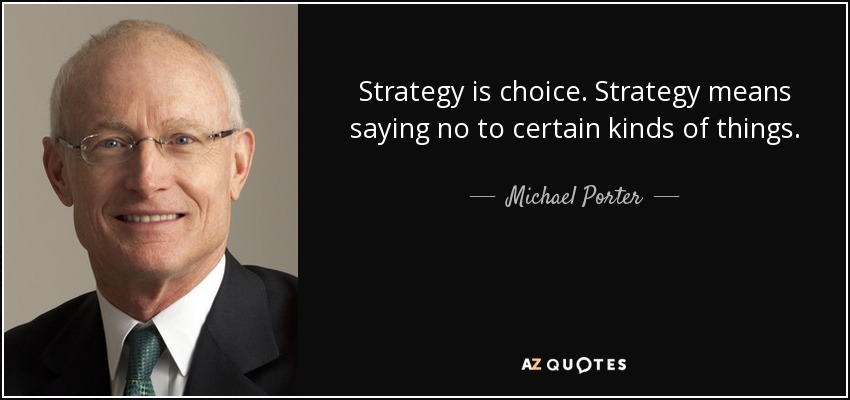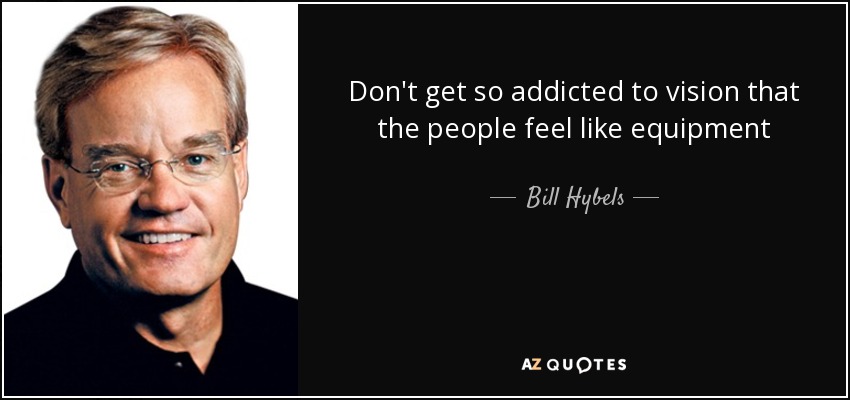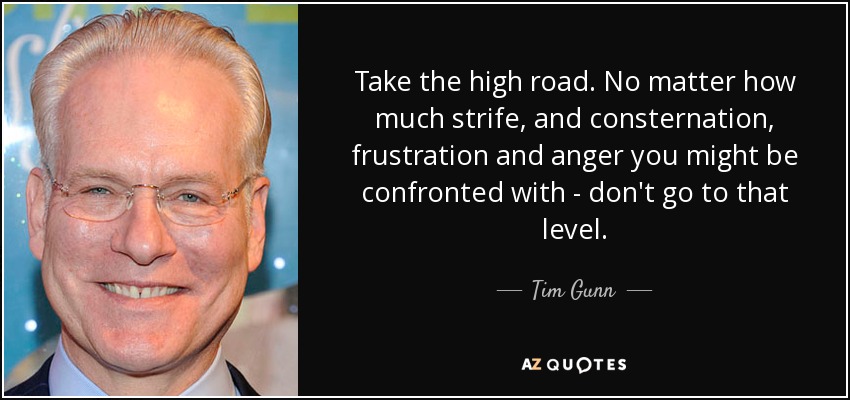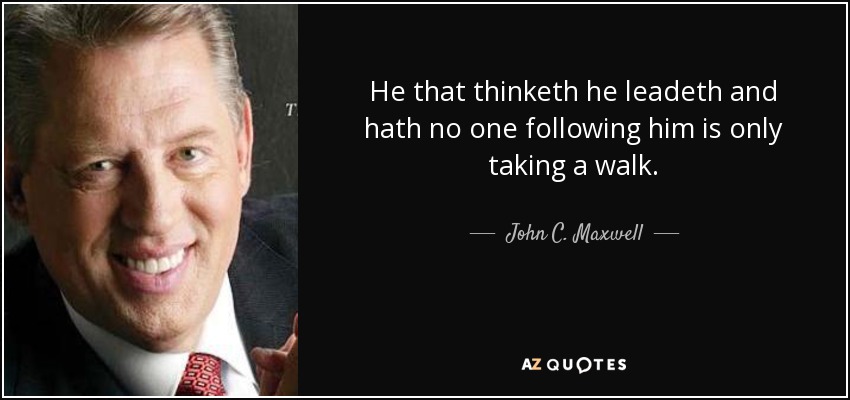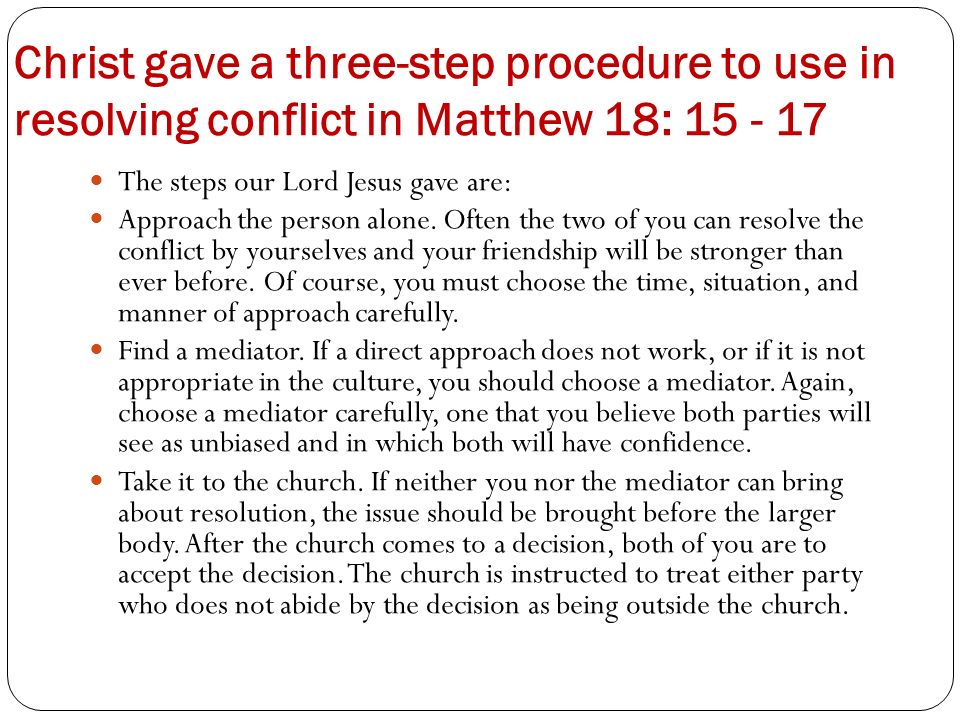Click here to return to Blog Post Intro
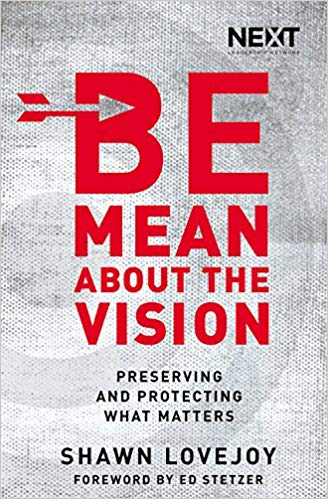
Being Mean
First, there are too many mean leaders out there today. Being mean about the vision is not about being mean to people. In fact, it’s exactly the opposite.
Another definition of the word mean is “to have an intended purpose.” In this instance, the word mean has to do with intent. We’ll say, “I didn’t mean that…”
Being “mean” about the vision is being intentional about the vision. It’s purposefully protecting the vision over time. Being mean about the vision is living it out daily in our lives, keeping our hearts focused and aligned with it. It’s communicating that vision with clarity and energy.
Everyone starts out with a vision, but few finish with one. Lovejoy’s book is about finishing with vision. When we forget why we do what we do, we’ll eventually lose our passion. It happens slowly and quietly.
You have to say no to many things before they even got a chance to get started, simply because they are not in line with the vision. In fact, the best time to stop an off-vision program is before it gets started.
The faster an organization grows, the easier it is to get off track and lose its way.
At the end of the day, a vision statement is just a statement. It has no life on its own. It cannot, nor will it ever, energize, unify, or align an organization. This task falls to the leader. A vision statement is only as strong as the leader is. Vision is only as clear as the leader is. Vision is only as compelling as a leader makes it. A vision is stewarded and sustained by a leader.
Leaders must care about these questions:
- Where are we going now?
- Where do we want to go?
- How do we take everyone there?
It’s one thing to say you have a vision. It’s another thing to live it out. That’s where being mean about the vision comes in.
It All Starts with Vision
In Genesis 32. Jacob found himself in a wrestling match with God (or at least a messenger from God). He wrestled all night, and Scripture tells us that during the struggle, Jacob refused to let go until God blessed him. Think about it: Jacob would not stop wrestling with God until God helped him fulfill His vision for Jacob’s life! And God did bless him. Everything great in Jacob’s life started with a holy wrestling match over the vision. That’s powerful. If we are ever going to be able to be mean about the vision, we cannot skip over the wrestling process.
None of us actually invents the vision for our lives, churches, and organizations. We were created by God for His purposes, so we discover God’s vision for our lives through our relationship with Him. If we try to go off by ourselves and invent the vision, we will make a mess of things. So how do we get the vision from God? Start with the Bible. There’s a reason they call it God’s Word.
The Bible is clear that the overarching vision for our lives should be driven by love: loving God and loving others as much as we love ourselves. God’s vision for all of our lives is the same in these three important ways: (1) love and serve Him, (2) love and serve others, and (3) share the good news.
When we’re unsure of our own vision, or insecure in our own leadership, it’s tempting to try to copy someone else’s vision. There is a problem with copying a preexisting vision: we simply won’t protect a knockoff—a vision that’s not ours. Don’t rip off someone else’s vision. God has something better—much more authentic—that’s meant just for you.
The most important thing you can do is wrestle with God until His vision for your life and organization becomes clear. To be mean about the vision, we must believe that God has uniquely revealed it to us.
Do you know God’s purpose for your life? It’s probably connected to that holy discontent. If you’ve never had the terrible privilege of wrestling with God over a vision, know that it’s far too valuable to skip over!
The word vision is actually best translated revelation. The New International Version of the Bible translates this verse even more literally from the original Hebrew: “Where there is no revelation, the people cast off restraint.”
If we don’t understand the vision God has for our lives, we will drift through life, pursuing whatever catches our eye, and bouncing from one shiny and attractive thing to another. Without the guidelines, the “restraint” of a clearly defined goal, everyone will be pulling different directions. As leaders, we must be headed in a clear, consistent direction before anyone will go with us. Our vision serves as our compass—our true north on our journey. Better than that, it comes with a Guide.
Vision & Success
Any organization can be successful if three key points are in place:
- The organization’s vision is clear
- The vision is compelling
- There is consistency over time.
Put another way: Success = Clear Vision + Compelling Communication + Consistent Direction
Vision is the deal breaker or deal maker! Frankly, we shouldn’t worry so much about concocting something new and exciting. God’s vision for the church is already compelling. What we need is the wisdom to contextualize the vision for our environment, culture, and the people we’re trying to reach. That’s really the hard work of vision.
Jim Collins asserts that the best leaders concentrate more on “architecting” an enduring institution over time, rather than simply relying on their own charismatic personalities to keep everything propped up. Jim calls this type of leader a Level 5 Leader. A Level 5 Leader is one who doesn’t have to be the most charismatic person in the room. Instead he or she focuses on building a consistent vision that people can trust and rely on over time.
Clever values don’t create culture. Consistent ones do. What we value is important, but how deeply we value and hold to it is more important.
If you go to work at a visionary company, you will either fit and flourish—probably couldn’t be happier—or you will likely be expunged like a virus. It’s binary. There’s no middle ground. It’s almost cult-like. Visionary companies are so clear about what they stand for and what they’re trying to achieve that they simply don’t have room for those unwilling or unable to fit their exacting standards.
In reality, visionary companies are focused primarily on beating themselves. “How can we improve ourselves to do better tomorrow than we did today?” They never believe they are “good enough.”
Great organizations tend to be more focused on the process than product. They concentrate on the fundamentals of building a great company and allow the results to take care of themselves; and they usually do.
A Vision We’re Willing to Die For
If your vision ever has a chance of becoming a reality, it must be such deep-seated moral conviction that you’re willing to do anything to see it through. You must believe the vision is even bigger than you.
Thousands of years after King David lived and died, Luke, the author of the book of Acts, said this about him: “Now when David had served God’s purpose in his own generation, he fell asleep; he was buried with his ancestors and his body decayed” (Acts 13:36). What a way to sum up a life!
It doesn’t matter how big or small our vision is. Our responsibility is the same. We steward well whatever we’ve been given. We not only need to protect it; we need to grow it, multiply it, and honor our Master with it. Stewarding the vision well is one of the most important ways to honor God.
Don’t listen to people who tell you the dream is too big. If you do, your dream will not only die; you will die slowly on the inside as well. You may or may not be successful with your dream, but you must try. You have what it takes because God put this vision in you!
We can’t be successful at everything. We won’t win if we try to do everything. One of the most common mistakes organizations make is trying to do too much. As the vision becomes clearer, it will be just as important that you decide what not to do as it will be what you’re going to do. You cannot be all things to all people.
Our focus will largely determine the level of our success. Talent is not enough. Busyness does not equal effectiveness. Discipline and focused intensity over time is where it’s at.
Keeping the Vision Alive in Me
Bill Hybels, former pastor of Willow Creek Church, once used the phrase “vision leaks.” Vision just has a way of losing steam over time. People and organizations try to do too many things.
No matter how clear the vision is, no matter how convincingly we communicate it, vision will trickle out. It leaks faster than we think it does too. Hybels said that vision leaks every six weeks.
Being mean about the vision requires consistently recasting the vision in creative ways. Out of all the questions we must wrestle with, though, there’s one question that’s more important than all the others: “Why?” Why are we doing this? Why do we want to do this? Why are we dreaming what we’re dreaming? Why should anyone care?
Why do you want to build what you’re building? To be big? To be famous? To have a platform? Jesus said “For where your treasure is, there your heart will be also” (Matt. 6:21).
Lovejoy explains, “Whenever I have forgotten why I do what I do, I turn into a restless, dogmatic, impatient guy who will run over people and use them to get work done. I become mean in the worst sort of way.”
Henry Blackaby, author of Experiencing God, notes that “spiritual markers”—times of decision when we clearly knew that God has somehow guided us—are important to holding fast to the vision. Remembering the why behind the what always produces new passion, but it also restores it when it’s been lost!
Before we can cast the vision to others, we have to begin with ourselves. Remembering your passion, and refreshing your spiritual discipline, will plug your personal leak. Return to the source of the vision to fill up your bucket again. Once you do, everything gets easier from there.
Keeping the Vision Alive in Others
A mission will spread only to the extent it can be remembered and communicated in a clear, compelling way!
We must refuse to stop talking about the vision until it completely saturates every person in every corner of our organization! When everyone knows the vision, is compelled by it, and contagiously shares it with others, the vision becomes unstoppable.
Whatever it may look like for you, being mean about the vision requires consistently keeping it in front of people: both verbally and visually.
Try looking up all the times Jesus tried to get away from the crowds of people who followed Him. He wasn’t just trying to get away from people. He wanted to be with His leaders—the disciples. Jesus recognized that in the long run, if His leaders didn’t get the vision, none of His followers would. Jesus was the quintessential leader. He understood that influence multiplies more rapidly when the leaders fully understand and embrace the vision.
Vision alignment among leaders requires two fundamental things: proximity and consistency. We must be with them consistently, or distance decay will prevail. Vision drift will happen. The leak will become too big to plug.
Keeping the vision in front of your leaders and keeping the vision from leaking in your leaders is the most important part of your leadership of others!
In John Ortberg’s The Life You’ve Always Wanted, he talks about slowing down long enough to truly enjoy God and what He is doing in and around our lives. He calls it the spiritual discipline of celebration. Celebration is needed, not only for the leader but for the entire team. We all need to know that we matter. We all need to know that we’re making a difference, and to be reminded that the vision is happening!
Look for ways to celebrate the vision. Circle back around and talk about goals that have been accomplished. Talk about the lives that are being changed. Be specific. Share stories. Ask for testimonies. Give rounds of applause, and display people’s accomplishments. Celebrating when the vision actually happens in and through a person’s life is the ultimate “atta boy.” It cheers people on and moves them to want to be a part of what’s happening. Remember, people are more often persuaded by passion than logic.
Maybe you need to throw away the notes and the agenda this week and just share from your heart. Take everyone back to the beginning. Tell the story. Tell everyone why you are here. Remind them why this is important and ask them to sacrifice with you. Remember: where there is no vision the people perish. The flip side is also true. Where there is a vision, there is life.
Identifying a Vision Hijacker
No matter how clearly, consistently, or creatively we communicate the vision, some people just won’t get it. First Timothy 3 cautions church leaders about putting people into leadership too quickly, without knowing their true character and reputation. We can filter out some vision mavericks by slowing down our leadership placement process.
Vision mavericks usually want to lead but cannot follow. The kinds of leaders we are looking for must know how to do both.
As leaders we need to be willing to listen to people’s feedback and suggestions. So how and when is listening to feedback and suggestions appropriate? Consider the source. Listen to feedback and constructive critiques from people who love God, love the vision, and loves you.
Keeping the Vision from Being Hijacked
We need to be very careful about who we allow into leadership in our organizations. Leadership is a privilege, not a right.
The old adage “hire slow and fire fast” applies most to leaders. We need to be slow in placing people into positions of power. There is no foolproof way to know whether a leader will fit before they are on the team.
Most of us have heard of some variation of the Four C’s: Character, Capacity, Chemistry, and Calling. These two aspects in particular are the most overlooked on the front end:
- Don’t Overlook Character: Don’t just call references, but get permission to call references of references. Ask the candidate to give you the name of a person who doesn’t like them very much right now.
- Don’t Overlook Chemistry: Leaders in an organization have to like each other. There has to be relational chemistry. We have to like each other to trust each other. We have to trust each other to share the same vision.
How do you assess relational chemistry? Spend extended time with people. The higher the level of leadership, the more time you should spend with them before hiring them.
Mark Beeson, pastor of Granger Community Church, in Granger, Indiana, say: “The most dangerous deviations from the vision are those situations where someone is just 1 percent off. It’s easier to spot and deal with someone who’s diametrically opposed to the vision than it is with someone who’s just barely off.” The sooner you confront any perceived vision drift, the better.
About 75 percent of the time, when you provide a safe place for a person to be honest about their struggles with the organization’s vision, they will take the opportunity.
There are too many insecure leaders in our world who believe that everyone everywhere is a threat. We need to be secure enough in our own skin to believe that not everybody is out to take us down or take down the vision. Remember, the goal of every confrontation is to redeem relationships and protect the vision.
The longer we allow disunity to go unaddressed, the more it will fester, spread, and grow.
When It’s Not Working Out
What We Owe Our Team
- Grace: We owe every team member grace. We should not expect perfection. We should overlook offenses and flaws, and give team members time to morph, grow, and change. Team members need to believe that we always have their best interests at heart.
- Honesty: We owe each team member honesty. Former Pastor Bill Hybels of Willow Creek Community Church once spoke about conversations that cover “the last 10 percent.” The idea was that in most of our day-to-day interactions, we deal in the safety of exposing 90 percent of ourselves, but we hide the last 10 percent: the stuff that makes for awkward conversations. Hybels explained that when a tough conversation needs to happen we should set a culture where we approach a person and ask permission to have a “last-10-percent conversation” where we are totally honest with each other.
In confrontational situations, we often lack the courage to be completely honest with the other person when we are in the room with them. It’s cowardly, if you think about it. Make a commitment to every new team member under your supervision, that you will never tell someone else something about them that you have not told them directly.
- Clarity and Accountability: Our team members also deserve clarity about the expectations we have for them. Lovejoy noted that in the churches and organizations he led, his teams conducted six-month reviews, as many organizations do. He called them Performance and Development Reviews and chose to make “sharing the vision” one of the criteria by which every team member was evaluated.
- Proper Placement: We owe our team members a fair shake in the right position that fits their skills and strengths.
- Prayer: We owe our team members our prayers. A team is only as strong as its weakest link. The longer an employee remains the weak link, the more difficult it becomes for that person, for us, and for the organization.
When chemistry is not there, we owe it to a team member to acknowledge it. It needs to be a relational fit for their benefit, for our benefit, and the benefit of the organization. If it’s sucking the life out of the vision, we need to deal with it.
Every team member should have a WIT (Whatever It Takes) attitude to get the vision accomplished. In years of ministry, I have found that some team members want to be part of a winning team, but they don’t want to pay the price of winning.
The Right Way to Let Someone Go
Don’t procrastinate. Don’t put this off. When you recognize someone is not working out, and you refuse to do anything about it, you become part of the problem.
Keep it one-on-one. Remember, we always owe this person grace—especially if it’s over an issue that’s out of their control, like chemistry. Schedule these types of meetings for the end of the day when most of the other staff members are leaving the office.
Use the right tone. Never release someone in a heated moment. This meeting is about protecting the vision. Tell them that.
Don’t beat around the bush. Start with the positive. Thank the employee for saying yes in the first place to their position. Thank them for their hard work. Talk about the things they’ve done to add value.
Be specific. Tell them exactly why this release is happening. Be gentle but be specific. There’s no need for a laundry list of what they’ve done wrong. Just pick one or two overarching reasons why this is not going to work out.
Acknowledge your pain. Let the employee know that you have lost sleep over this decision. Tell them this is not easy for you. Tell them this hurts you. Tell them you love them (we should, you know).
Acknowledge their pain as well. Let them know you realize there have been frustrating times as of late. You know things have been difficult for them.
Put everything in writing. Good paper makes good friends. Everything needs to be on paper in terms of an exit agreement.
Offer the high road. Tell them you would love to still be able to speak positively about them when you leave this meeting. Talk about how you would like to handle the communication of the employee’s exit from the team.
Remember: we owe them grace, honesty, clarity, and accountability, proper placement, and prayer!
End the meeting graciously. Lovejoy recalls, “To my recollection, I have ended every single one of these conversations with a handshake and even a hug! I have prayed for and with the team member.”
Remember this: short-term pain brings long-term gain. The organization and the vision are going to win because of these hard decisions.
Don’t Settle for Mediocrity
Alabama College Football Coach Nick Saban once made the statement in an interview that “mediocre people don’t like high achievers and high achievers don’t like mediocre people.”
Great football players’ number one pet peeve is having someone on the team who doesn’t give his best effort. They struggle with players who can’t get the job done. They hate having someone on the team that can’t pull his weight.
Mediocrity is a disease, and the disease is contagious. It’s like a cancer; if your organization is to live, the cancer needs to be removed. Otherwise it will spread, and it will kill. This is that serious!
A leader loses credibility every day a mediocre team member stays around. The great players on the team know who the mediocre player is. Most everyone can identify the weak link. Every day we tolerate them and don’t deal with their issues, people begin to wonder: Does our leader recognize what’s going on? Are they oblivious to the weak link? Courageous conversations build credibility within a team.
Getting Back on Track
What do we do when we look up and realize the vision has drifted?
For about a decade, there’s been an ongoing debate about whether a church should be attractional or missional. Basically, the two words describe the church’s paradigm for reaching new people. Should we ask people to come gather with us, or should we go to them and de-emphasize the large gathering? That argument seems a little foolish, because a church must be both! The church should invite people into our gatherings, whether it’s in a home or a large building, for worship and community—then commission them to live Christ’s love in our community, nation, and world!
What do we do when we realize that certain programs, approaches, methods, or strategies aren’t working anymore?
Model the Way
Behavior is more caught than taught.
Patience is a virtue, but here’s the challenge: have you met a patient leader? We love the thrill of going Mach 5 with our hair on fire. We love change. For leaders, change is like a drug. And we like to change things—a lot!
Once change has begun, stay close to the leaders. Have you ever heard of distance decay? With leaders, it’s more like distance destruction. Leaders drift faster than followers.
From our key people to the entire organization, everyone needs to know why change is good for them. Think about the why and the what. Remembering why we do what we do always creates passion.
No one is motivated by talking about “doing what’s best for the organization.” Leaders touch the heart before they ask for a hand. Leadership is not taking people where they want to go. It’s taking people where they need to go!
As leaders, we must never change simply for the sake of change. When we enact change in our organization, it should always be intentional and have everything to do with the vision.
Change is difficult. Enacting change not only requires a lot of courage; it requires clarity and commitment.
If we can keep our eyes on the vision during these long, tense seasons of change, we’ll see success. “Let us not become weary in doing good, for at the proper time we will reap a harvest if we do not give up” (Galatians 6:9).
When should you quit? When is the best time to step down? When there’s absolutely no reason to leave. You leave when things are on a high note. Leave when everything’s clicking.
Pleasing the Right Audience
We want to have a platform. We want to be recognized as successful, and to hear the world’s applause. Usually we’re doing what we’re doing with a particular audience in mind. One of the most eye-opening things we can discover about ourselves as leaders is which audience we’re trying to please, and why.
People pleasing and leadership can exist in a great tension. On one level, leaders must understand that people usually buy into us before they buy into the vision. People need to like us.
There’s a difference between pleasing people and being a people pleaser. While it’s important to be sensitive to others, pleasing people can never be our most important responsibility. At the end of the day, we must choose to please God first and foremost.
God has a calling for our lives. He has gifted us for a purpose. He has placed us where we are in leadership for such a time as this. Will we choose to please Him regardless of the perceived cost? In Esther’s case, after fasting and praying about it, she did the difficult thing. Regardless of what the king would think, or what all of Persia would think, Esther decided to honor God and trust Him with the outcome. She literally said, “If I perish, I perish” (Esther 4:16).
Leadership requires an incredible amount of courage. Sometimes we have to do what’s best for people even when it doesn’t please all of the people. There’s a difference between a critique and a criticism. Criticism might come from people who have a critical spirit or an ulterior motive. These people could have an agenda or selfish ambitions. Don’t listen to criticisms. Critics usually won’t come and talk to you face to face anyway.
Critics in this sense are often cowards. They usually don’t practice the process of confrontation found in Matthew 18, which begins with private, loving conversation.
Leadership is stressful. Followers make suggestions, but leaders make decisions. Leadership requires wisdom, discernment, courage, and sacrifice.
We always have enemies. Always—no matter how “nice” we are. Leaders get attacked, and must sometimes stand alone. Leadership can be lonely.
Releasing the Vision to a New Leader
The vision does not belong to the leader. The vision always belongs to God. The leader is only a steward, or manager, of the vision. Sooner or later, leaders have to recognize that the vision must outlive them for it to be successful long term. A leader’s greatest legacy is leaving behind a healthy, thriving organization.
If you think about it, all pastors are interim pastors. Every leader is an interim leader. What does an interim do? Pave the way for the next leader.
Leadership succession is one of the great challenges of any organization—especially for churches. There is no success without successful succession!
If we have hopes of handing the vision off in a healthy fashion, then the vision needs to be healthy when we hand it off. Our responsibility is always to leave people and things better off than when we left them, and to provide a return on God’s investment.
How will you steward the vision beyond you? Will the vision outlive and outlast you? Are you planning now to leave? Are you planning your exit? You should. It’s the best thing you could do for the vision, as it will outlive you. Isn’t that what you want?
Don’t Be Afraid

“Keep Calm and Carry On” was a motivational poster campaign led by the British government in 1939 in preparation for World War II. Around 2.5 million copies of this poster were printed in hopes of boosting morale among the British citizens as war loomed, but they never made it to posting. The movement was soon forgotten, out of sight and out of mind, until fifteen of the posters showed up on an episode of the Antiques Roadshow television series, and we know the rest. The movement went viral.
The interesting thing is the timing of the resurgence of the Keep Calm campaign, because there has never been a time in history when people more need to keep calm than today. It seems as if the art of staying calm has largely been lost in our society.
The cry of our day is for courageous leaders, not cowardly leaders.
Do you know what the most common command in the Bible is? “Don’t be afraid.” Trust that God is at work. See this through. Keep calm. That’s good advice, isn’t it?




